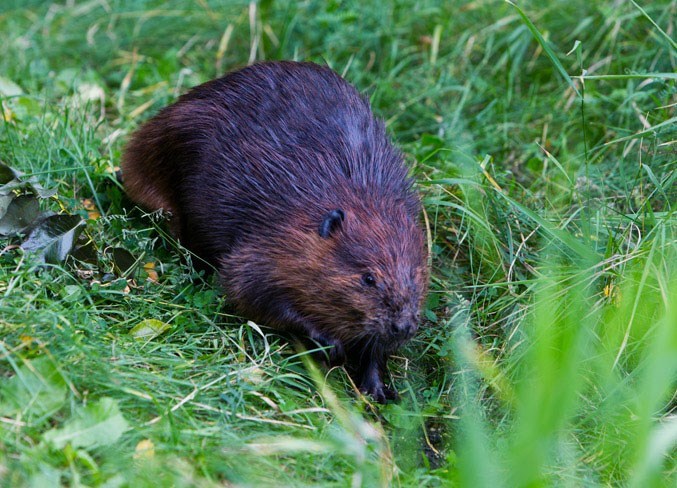The City of St. Albert plans to add a couple of new tools to its water-management tool belt over the next few years to counteract problems caused by the local beaver population.
Melissa Logan, the city's environmental coordinator, said staff will install pond levellers in high-priority spots throughout Carrot Creek and the Sturgeon River, starting this summer.
Unbeknownst to the estimated 16 individual beavers who call these rivers home, pond levellers allow water to flow through dams to prevent flooding, Logan said.
“The pond levellers you can put right in the middle of a dam and it will keep the water flowing through so that we don't get flooding, but still allow the beaver to create some of the habitat that it needs,” she said.
“It's just a method of coexisting with beavers on the landscape instead of getting rid of them entirely.”
A pond leveller is a pipe installed through a beaver dam with a protective fencing apparatus attached to the end. The fencing is necessary to stymie efforts by Canada's emblematic rodent to clog the pipe.
Logan says these pond levellers, as well as culvert protectors, are becoming increasingly necessary in parts of St. Albert's wetlands as resident beavers have caused significant, expensive damage.
“There's an inlet on Elke's Pond ... on Riel Drive by the Enjoy Centre, that has (a culvert) that's been been damaged by beaver,” Logan said. Another culvert in the stormwater management pond by the Enjoy Centre had to be repaired just last year.
Logan said beavers damage culverts, cylindrical pipes placed underneath roads to allow water flow, by creating clogs or even undercutting the pipe, which causes the structure to become unstable.
“To repair or even replace a culvert is a very expensive job,” she said.
“If it can be repaired that's what we'll do, but if it needs to be replaced then it involves removal of the old culvert, removal of the old concrete, regrading, installation of riprap, fencing — it's a very expensive piece of work.”
To avoid further and future damage, Logan said, city staff will be installing culvert protectors in high-priority spots.
Although there are a few different kinds of culvert protectors, they can generally be thought of as fencing or caging around culvert spouts that prevent beavers from creating water-jams.
“Best-case scenario is that beavers are still able to be active on the landscape and do their natural water management,” Logan said of what she hopes the new tools will accomplish.
“Protection of our infrastructure in the long term is really what we're looking for.”
Logan said staff will install the tools in high-priority areas this summer, and in lower priority areas over the next few years.
Major cost savings
Glynnis Hood, an environmental biology and ecology professor at the University of Alberta's Augustana campus in Camrose and author of The Beaver Manifesto (2011), told The Gazette she has seen pond levellers save municipalities thousands of dollars.
“There's cost savings, there's ecological advantages, (and) there's infrastructure advantages for reducing maintenance needs,” said Hood.
“For instance, in Cooking Lake-Blackfoot, we installed about 13 (pond levellers) and then we monitored them over seven years. The maintenance that was required ... was maybe pull a few sticks out here and there and they worked really well,” she said.
“The cost savings was in the tens of thousands of dollars, and if we added on some other economic drivers ... it could even be in the hundreds of thousands of dollars of cost savings just for those 13 sites that otherwise have been chronically flooded for over 10 years.”
Hood said pond levellers, culvert protectors, and other beaver-damage mitigation can improve how people in the community view their neighbourhood beavers.
“What we find is where there's chronic flooding by beaver or any sort of negative interaction from a human perspective with beavers on landscape, whether it's cutting trees or flooding, human perceptions on beavers is really quite negative,” she said.
Hood's research has found when steps are taken to reduce flooding or other beaver-caused problems, people often view the animals in a more positive light.
Hood said one of the few downsides with pond levellers is they require expertise to install; however, Logan said the city is working with an Alberta-based non-profit called Cows and Fish which will help install them.
Beavers as extreme-weather mitigators
As part of an ongoing five-year project, Hood and Dr. Cherie Westbrook from the University of Saskatchewan are studying how beavers and their dams might help mitigate extreme climate events, such as floods and droughts.
“Over 60 per cent of the beaver dams actually held even in the 2013 flood that devastated Calgary and downstream areas,” she said. “Many of the beaver dams were only partially breached or didn't breach at all.”
“They actually played a role in holding back some of that floodwater or at least delayed or slowed its downstream flow.”
Hood said it's too early to say definitively if beaver dams could be a significant tool during extreme-weather events in Alberta, but current data and modelling looks promising.
“In climate change, you're going to get more extreme-weather events, like these big rainfall events, but you're also going to get drought, and beavers (might) play a role in a natural and nature-based solution for some of these things.”
To learn more about beavers and, as Logan described, their unmatched water management engineering ability, Hood was recently featured in a TED-Talk YouTube video.



